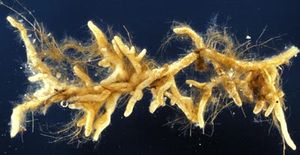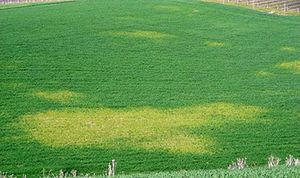Microorganisms
Definition

A microorganism is a form of life that can be single celled and can be formed in colonies of cells. These forms of life are almost all microscopic. The three main microorganisms are bacteria, fungi, and viruses. These microorganisms are extremely vital in everyday processes and especially in soil processes. [1]
Bacteria
A bacteria is a single celled microorganism or "microbe", that does not have a nucleus or any membrane bound organelles, therefore it is a Prokayote. The bacteria has a single loop of DNA which acts as the nucleus of the organism. Often there can be another strand of DNA that gives the bacteria a distinguishing feature that typically helps with survival. An example of this is the ability for some bacteria to be resistant to certain antibiotics, or some bacteria being able to survive in conditions with a higher pH than typical bacteria.
Bacteria reproduce by binary fission which means the single cell will split into two daughter (identical) cells, which then split into four, and so forth! Replication by binary fission is often a very fast process, but there are a few important steps involved. [3]

Step 1: At the origin of previous replication, the strand of DNA begins to unravel and prepare for replication!
Step 2: The cell then elongates two prepare to slit and to contain both copies of the DNA!
Step 3: A septum forms down the center of the cell which is the start of the cell splitting. In this phase, the DNA migrate to each side of the cell!
Step 4: The septum continues down the entire cell and the cell splits into two identical cells. [2]
Binary fission in bacteria can happen so fast that in 8 hours, 16,777,216 bacteria can be formed from just one single celled bacteria. [3]
Bacteria is important to almost every soil process on the planet, which means that bacteria can survive in very harsh conditions; Whether it be in high temperatures, low temperatures, anoxic places, and areas in differing pH. A reason why bacteria is important to soils because they were one of the first organisms to begin decomposition of residues in the soil. Another and even more important role that bacteria fill is fixing nutrients for plant and other soil fauna uptake. Bacteria are responsible for dissolving phosphorus so that it is readily available for plants, and phosphorus is one of the key ingredients to a thriving plant. Also, bacteria fix nitrogen (Nitrogen fixation) in the soil so that it is readily available to plants nearby. Plants and most other organisms are not able to utilize nitrogen gas (N2), but bacteria can use the nitrogen gas and convert it to a form that is beneficial for plant uptake. This is why you will find most bacteria in the rhizosphere where all of the plant roots typically are. [1]
Fungi
Fungi is an organism that can be single celled or can be very complex and multi-cellular. The cells of a fungus have a nucleus and membrane wrapped organelles, there fore it is a Eukaryote. Fungi can live almost everywhere, similarly to bacteria, but they tend to grow on terrestrial areas, specifically on decaying plants. Fungi can reproduce asexually and sexually, depending on the species and the environment around the fungus. This gives the fungus a great advantage over many other organisms because this organism is more hardy and able to reproduce than others.
Fungi are so important to soil processes because it was one of the first organisms that first started to decompose lignin in plants. Before fungi were around, dead plant material was able to pack down below the ground and form what we consider our non-renewable fuel sources. Once fungi came around, the plants were decomposed before they could turn into the oils in the earth. Therefore fungi are also responsible for carbon cycling, along with the cycling of many other elements. [3]

Fungi can be extremely beneficial to plants in the soil, or detrimental to the plants in the soil. Ectomycorrhizal fungi (Ectomycorrizae) have a vital association with plant systems including pine trees, and even certain crops in agriculture. These associations between higher fungi and the plants create a network of fungi hyphae on the root systems which help in the uptake of many important compounds for the plant. The fungi create a great surface area and act as a filter for the roots of plants to increase uptake of the nutrients, all while the fungi can take in some nutrients also. The fungi are also able to fix nutrients that the plant could not readily take up without. [4]
Fungi can also negatively effect plants including the very expensive and delicate crops of a farmer. Fungi are responsible for diseases like downy-mildew, root-rot, and apple scab. So even though fungi can be a great tool to fixate nutrients for plants, they can also starve plants from their nutrients, and infect the plant with diseases that can wipe out the entire crop. Fungi are known to be a costly enemy to the farming industry, but there are many precautions a farmer can take to prevent fungal disease. [1]
Viruses

Viruses are the smallest of all Microbes, and are single celled organisms. A virus is composed of genetic material in the form of DNA or RNA surrounded by a shell of protein called the "capsid". In some viruses, there is an envelope surrounding the capsid which is a spiky coat around the capsid that assists with the virus transferring to it's host. A virus is not considered a prokaryote or a eukaryote because it does not display the characteristics of a living organism. This is backed up by the fact that the virus can only survive when it is in it's host. [3]
Viruses multiply by budding and by a process called lysis. When budding, a new viral particle will be take over the host cell until the cell ends up dying. The cell dies because the virus uses the membrane of the host cell to create the envelope around the virus. In lysis, the host cell that is infected with the virus will burst open because of the new viral particles pressing outward, which results in death to the host cell. There are then many new viral particles ready to take over a new host cell to repeat the process. [3]
Viruses are found in almost all domains of soil, and they play an important role in those soils. There are viruses that are currently captured in the ice of Antarctica that have not been released in thousands of years. Primarily, viruses have a negative effect on soil processes because they can prohibit the uptake of nutrients to the plants indirectly. Viruses can destroy helpful bacteria and fungi, resulting in the loss of important nutrient fixation and cycling. Viruses do however play an important role in genetic diversity and nutrient storage in soils. Viruses can be trapped and house a lot of nutrients for a long time, keeping them out of that specific nutrient cycle. Also, there can be old and unknown genetics trapped in viruses that can maybe be helpful to human technology. [5]
References
[1] Nationwide, SARE. “Soil Microorganisms.” SARE: Sustainable Agriculture Research and Education, www.sare.org/Learning-Center/Books/Building-Soils-for-Better-Crops-3rd-Edition/Text-Version/The-Living-Soil/Soil-Microorganisms.
[2] “Bacterial Binary Fission.” Khanacademy, www.khanacademy.org/science/biology/cellular-molecular-biology/mitosis/a/bacterial-binary-fission.
[3] “About Microbiology – Bacteria.” Microbiology Online, Microbiology Society, microbiologyonline.org/about-microbiology/introducing-microbes/bacteria.
[4] “MYCORRHIZAL ASSOCIATIONS: The Web Resource.” Mycorrhizal Associations: Ectomycorrhizas, mycorrhizas.info/ecm.html.
[5] “Viruses in Soils.” Viruses in Soils | Cell and Molecular Sciences | Research | The James Hutton Institute, www.hutton.ac.uk/research/groups/cell-and-molecular-sciences/virus-research/viruses-soils.
[6] “Washington State University.” Wheat & Small Grains | Washington State University, smallgrains.wsu.edu/disease-resources/virus-diseases/soilborne-wheat-mosaic/.